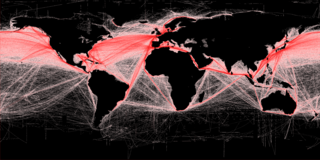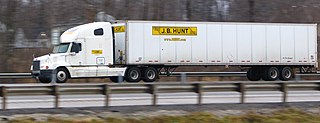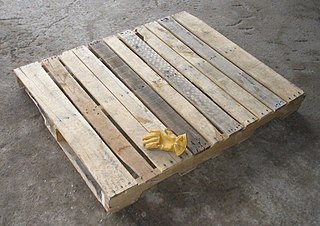
Freight transport is the physical process of transporting commodities and merchandise goods and cargo. The term shipping originally referred to transport by sea but in American English, it has been extended to refer to transport by land or air as well. "Logistics", a term borrowed from the military environment, is also used in the same sense.

United Parcel Service (UPS) is an American multinational package delivery and supply chain management company.

Intermodal freight transport involves the transportation of freight in an intermodal container or vehicle, using multiple modes of transportation, without any handling of the freight itself when changing modes. The method reduces cargo handling, and so improves security, reduces damage and loss, and allows freight to be transported faster. Reduced costs over road trucking is the key benefit for inter-continental use. This may be offset by reduced timings for road transport over shorter distances.
Cross-docking is a practice in logistics of unloading materials from an incoming semi-trailer truck or railroad car and loading these materials directly into outbound trucks, trailers, or rail cars, with little or no storage in between. This may be done to change the type of conveyance, to sort material intended for different destinations, or to combine material from different origins into transport vehicles with the same or similar destinations.
Freighting refers to the hauling of cargo, historically, using a dog team to mush goods cross-country. During the North American gold rushes, such as the Klondike Gold Rush, dogs were valuable draft animals, going where horses could not and withstanding harsher weather.
A freight rate is a price at which a certain cargo is delivered from one point to another. The price depends on the form of the cargo, the mode of transport, the weight of the cargo, and the distance to the delivery destination. Many shipping services, especially air carriers, use dimensional weight for calculating the price, which takes into account both weight and volume of the cargo.

J.B. Hunt Transport Services is a transportation and logistics company that was founded by Johnnie Bryan Hunt and Johnelle Hunt, and it is based in the Northwest Arkansas city of Lowell.
Dimensioners are weighing and volume measuring systems for measuring three-dimensional or cube-shaped objects such as packages, parcels, pallets, cartons and boxes. They are frequently used as part of a much larger logistical system in a distribution center, warehouse or trucking terminal facility. By knowing exactly how much space a parcel, object or pallet will occupy, warehouses and shipping companies are able optimize the space available to them.
Transloading is the process of transferring a shipment from one mode of transportation to another. It is most commonly employed when one mode cannot be used for the entire trip, such as when goods must be shipped internationally from one inland point to another. Such a trip might require transport by truck to an airport, then by airplane overseas, and then by another truck to its destination; or it might involve bulk material loaded to rail at the mine and then transferred to a ship at a port. Transloading is also required at railroad break-of-gauge points, since the equipment between lines is not compatible.
A specialized set of jargon describe the tools, equipment, and employment sectors used in the trucking industry in the United States. Some terms may be used within other English-speaking countries, or within the freight industry in general. For example, shore power is a term borrowed from shipping terminology, in which electrical power is transferred from shore to ship, instead of the ship relying upon idling its engines. Drawing power from land lines is more efficient than engine idling and eliminates localized air pollution. Another borrowed term is "landing gear", which refers to the legs which support the front end of a semi-trailer when it is not connected to a semi-truck. Some nicknames are obvious wordplay, such as "portable parking lot", in reference to a truck that carries automobiles.

Con-way Freight was a less-than-truckload (LTL) motor carrier headquartered in Ann Arbor utilizing a network of freight service centers to provide regional, inter-regional and transcontinental less-than-truckload freight services throughout North America. The business unit provided day-definite delivery service to manufacturing, industrial and retail customers. Con-way Freight was the largest division of Con-way, Inc. with 16,600 employees, more than 365 operating locations, 16,000 dock doors and 32,750 tractors and trailers. The company was founded by Consolidated Freightways (CF) of Portland, Oregon as a non union spinoff, for less than truckload hauling. In 2009 Con-way Freight reported revenues of over $2.6 billion. On September 9th, 2015 Conway Inc. was acquired by CEO Bradley Jacobs of XPO Logistics, Inc. Roughly a year later, on October 27th 2016, XPO completed the sale of its recently acquired full-truckload division from Con-way Freight to the Canadian based TransForce for $558 million in cash.

Access America Transport was a third-party logistics provider of transportation and logistics services. The company, based in Chattanooga, Tennessee, operated nine offices and serviced customers throughout North America. Access America's services included: truckload shipping, less than truckload shipping, intermodal, specialized transportation, and supply chain management. Access America Transport was one of the fastest growing transportation and logistics service provider in North America.

Corrugated box design is the process of matching design factors for corrugated fiberboard boxes with the functional physical, processing and end-use requirements. Packaging engineers work to meet the performance requirements of a box while controlling total costs throughout the system.
TFI International Inc. is a Canadian transport and logistics company based in Montreal, Quebec. It operates across Canada through 4 business segments, and in the United States. It has Canada's largest LTL business, largest trucking fleet and ranked 14th in terms of revenue in 2005 among North American LTL carriers (however more recent lists such as suggest it may be closer to top 5. Its trucking fleet consists of 6700 power units and 12000 trailers. Two thirds of business comes from operations in Eastern Canada while the rest is from Western Canada.

Old Dominion Freight Line is an American less than truckload shipping company. It offers regional, inter-regional and national LTL service. In addition to its core LTL services, the company offers logistics services including ground and air expedited transportation, supply chain consulting, transportation management, truckload brokerage, container delivery and warehousing, as well as household moving services. It contracts with freight forwarding services throughout the world.
A freight broker, in freight transport (cargo), over land in the United States by truck is often used as part of the logistics. This may be part of an overall shipbroking using a cargo broker, a freight forwarder, third party logistics broker (3PL), and even a fourth-party broker, when outsourcing is needed for freight transportation. The brokering can be single mode or by multimodal transportation and can use specialized brokers on a permanent basis or as needed to ensure timely traffic management.












